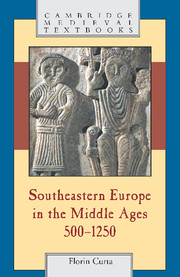Book contents
- Frontmatter
- Contents
- List of maps
- Acknowledgments
- Note on transliteration, names, dates, and words
- Chronology
- List of abbreviations
- Introduction
- 1 The end of Late Antiquity or the beginning of the Middle Ages (c. 500–c. 600)?
- 2 Southeast European “Dark Ages” (c. 600–c. 800)
- 3 The rise of new powers (800–900)
- 4 Iron century or golden age (900–1000)?
- 5 The first Byzantine century (1000–1100)
- 6 The second Byzantine century (1100–1200)
- 7 Between the Crusade and the Mongol invasion (1200–1250)
- 8 Conclusions and lingering questions
- Select Bibliography
- Index
- Cambridge Medieval Textbooks
5 - The first Byzantine century (1000–1100)
Published online by Cambridge University Press: 05 June 2012
- Frontmatter
- Contents
- List of maps
- Acknowledgments
- Note on transliteration, names, dates, and words
- Chronology
- List of abbreviations
- Introduction
- 1 The end of Late Antiquity or the beginning of the Middle Ages (c. 500–c. 600)?
- 2 Southeast European “Dark Ages” (c. 600–c. 800)
- 3 The rise of new powers (800–900)
- 4 Iron century or golden age (900–1000)?
- 5 The first Byzantine century (1000–1100)
- 6 The second Byzantine century (1100–1200)
- 7 Between the Crusade and the Mongol invasion (1200–1250)
- 8 Conclusions and lingering questions
- Select Bibliography
- Index
- Cambridge Medieval Textbooks
Summary
Even before his final victory over Samuel and his followers Gabriel Radomir and John Vladislav, Emperor Basil's war against Bulgaria had a considerable influence upon political and military developments in the neighboring regions. The so-called Long Life of Saint Gerald, an early fourteenth-century compilation of different sources, contains a much earlier and extraordinary account, perhaps written by an eyewitness, of a chieftain ruling over the region of western Romania and southwestern Hungary now known as Banat. Named Achtum, he was a powerful pagan “king” who “had taken his power from the Greeks” and had been baptized in the Orthodox faith in Vidin, an event that must have postdated the Byzantine conquest of that city in 1002. His base of power was in Morisena (now Cenad, on the Romanian–Hungarian border), a stronghold on the Lower Mureş River, close to its confluence with the Tisza. Shortly after his baptism in Vidin, Achtum established a monastery dedicated to St. John the Baptist in Morisena, which he populated with Greek monks, no doubt coming from Byzantium. Achtum's power was based on considerable resources, mainly cattle and horses, but given the position of his stronghold at Morisena, he also controlled traffic along the Mureş River and taxed transports of salt from Transylvania to the heartland of Pannonia. It is in relation to salt that he found himself in conflict with Stephen, the newly proclaimed king of Hungary.
- Type
- Chapter
- Information
- Southeastern Europe in the Middle Ages, 500–1250 , pp. 248 - 310Publisher: Cambridge University PressPrint publication year: 2006



